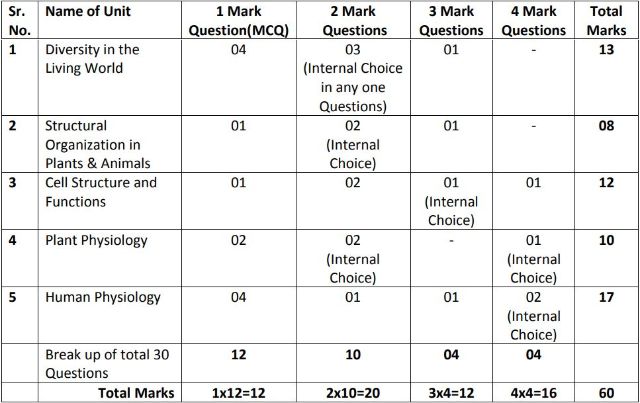HPBOSE Class 11 Biology Syllabus 2023-24: The HP Board Class 11 Bioloy Syllabus is an important resource for not only planning the strategy to complete the course effectively but also for preparing for exams in a way to obtain maximum marks. The topics’ details mentioned in the syllabus help students know what to cover for the subject while the marking scheme revealed by the syllabus helps them to know which topics need to be focused on for exam preparations. In this article, we have provided the HPBOSE Class 11 Biology syllabus in PDF format. Students can download the syllabus and go through it to know the course structure, Course content, marking scheme and question paper blue print for the 2023-24 session’s annual exam. Check and download the syllabus below:
HP Board Class 11 Biology Syllabus 2023-24
Course Structure
|
Unit |
Title |
Marks |
|
I |
DIVERSITY IN THE LIVING WORLD |
13 |
|
II |
STRUCTURAL ORGANIZATION IN PLANTS & ANIMALS |
08 |
|
III |
CELL: STRUCTURE AND FUNCTIONS |
12 |
|
IV |
PLANT PHYSIOLOGY |
10 |
|
V |
HUMAN PHYSIOLOGY |
17 |
|
Total |
60 |
|
Unit-I : Diversity in the Living World
Chapter-1 : The Living world
What is living? Diversity in the living world Taxonomic categories, Taxonomical Aids, Binomial Nomenclature
Chapter-2 : Biological Classification
Need of Classification, Two Kingdom & Five kingdom classification systems, salient features and classification of kingdom Monera, Protista , Fungi, Plant & Animalia Viruses, Viroids & Lichens.
Chapter-3 : Plant Kingdom
Artificial and Natural systems of Classification, Classification of Plants into major groups, salient and distinguishing features and a few examples of Algae, Bryophytes, Pteridophytes, Gymnosperms and Angiosperms. Plant life cycles and alternation of generations (topics Excluded).
Chapter-4 : Animal Kingdom
Basis of Classification, salient features and classification of animals – non chordates
Upto phyla level and chordates upto class level. ( salient features and few examples of each category)
UNIT II : Structural Organization in Plants & Animals
Chapter 5 : Morphology of Flowering Plants
Morphology of Different parts of Flowering plants- Roots, Stem, Leaf, Inflorescence, Flowers, Fruit & Seed. Description of family Fabaceae and Solanaceae.
Chapter 6 : Anatomy of Flowering Plants
The tissues & tissue systems, Anatomy of Dicotyledonous and Monocotyledon plants, Secondary Growth (introduction only)
Chapter 7 : Structural Organization in Animals
Animal Tissues- Their types & functions Morphology, anatomy and functions of different system of Earthworm, Cockroach & Frog.
UNIT III : Cell Structure & Functions
Chapter 8 : Cell: The Unit of Life
Cell as the basic unit of life, Cell Theory, structure of Prokaryotic & Eukaryotic cell, Plant & Animal cell,
Cell Membrane, Cell wall, cell organelles- structure & function, endo membrane system , endoplasmic reticulum, golgi body, lysosomes, vacuoles , mitochondria, ribosome, plastids, cytoskeleton, cilia & flagella, centrioles and nucleus (cultrastructure & functions), Micro bodies.
Chapter 9 : Biomolecules
Chemical constituents of living cells ,primary and secondary metabolites , biomolecules, structure and functions of carbohydrates , proteins, lipids and nucleic acids, nature of bonds linking a monomer in a polymer , concept of metabolism , metabolic basis for living, the living state, Enzymes, Enzyme- nature, mode of action factors affecting enzyme activity, their classification & nomenclature.
Chapter 10 : Cell cycle & cell division
Cell cycle & its phases, mitosis meiosis division with elaborate diagrams and their significance.
UNIT IV : Plant Physiology
Chapter 11 : Transport in Plants
Means of transport, Plant water Relations, Long Distance Transport of water Transpiration, Uptake and Transport of Mineral Nutrients, Phloem transport. Mass Flow hypothesis (excluded)
Chapter 12 : Mineral Nutrition
Macro and Micronutrients & their role in plant growth & development, Process of Biological Nitrogen fixation. Nitrogen Cycle (excluded).
Chapter 13 : Photosynthesis in Higher Plants
Importance of Photosynthesis- its site, pigments involved in the process, Light, Reaction. The Electron Transport Chain, Cyclic & Non cyclic Photophosphorylation, Chemiosmotic Hypothesis , The Calvin Cycle, ETS Pathway , Photorespiration, Factors affecting photosynthesis.
Chapter 14 : Respiration in Plants
Cellular Respiration- Glycolysis, fermentation (anaerobic) TCA cycle, ETS & Oxidative Phosphorylation (Aerobic), Respiratory Balance Sheet, Amphibolic Pathway, Respiratory Quotient.
Chapter 15 : Plant Growth & Development
Growth, Phases of Growth, Growth Rates, Differentiation, Dedifferentiation & Redifferentiation processes in a plant cell. Various Plant Growth Regulators – [auxins, gibberellins, cytokinines , ethylene & ABA –Their physiological effects & agricultural uses, Photoperiodism – (SDP ,LDP & DNP) and their examples.
To check the contents and experiments prescribed for practicals, download the full syllabus from the following link:
HP Board Class 11 Biology Exam Pattern and Marking Scheme 2024
|
Biology (Theory) |
60 Marks |
|
Practical |
20 Marks |
|
Internal Assessment |
20 Marks |
|
Total |
100 Marks |
Design of HPBOSE Class 11 Biology Question Paper 2024
Biology (Theory) paper in HP Board Class 11 will be of 60 Marks with a time duration of 3 hours. The question paper blue print is as follows:
HP Board Class 10+1 Biology Question Paper 2024 Blue Print
Time: 3 hours
Maximum Marks: 60

Blue Print of MCQs
- Each MCQ carries 1 mark only
- No internal choice in the MCQ section
Prescribed Books
Biology Published by HPBOSE Dharamshala

